My apologies for the delayed uploading , we were docked yesterday in such a way that the funnel blocked the Internet connection.
And so after a lot of preparation the big drill took place. The objectives had been read.
Long discussions took place about how to do this and then it was time for the real action. The main challenge to deal with was, all the water that was produced by the 5 fire hoses hooked up behind the wooden wall, simulating the ship’s hull. That hole was the simulated breach in the hull and the water spouted though.
Using the mooring deck instead of the Engine Room itself makes it somewhat harder to visualize what is exactly going on but the fountains of water did help the focus.
Two firefighting teams attacked and once the area was declared safe from any danger,
apart from the water, the hole was plugged with a special gadget that we have for these sorts of things.
It is a half sphere with an angle bar on a threaded shaft, which can then be tightened up with a wing nut. The angle bar is stuck through the hole and pulled tight against the hull and then the half sphere can be tightened against the inside of the hull and thus close off the hole and thus stop the ingress of water.
It took quite a bit of man power to hold the half sphere in position against the force of the water but eventually everything was in position.
The good ship Rotterdam was in the meantime still heading towards Santa Cruz de Tenerife. Heading on a North Easterly course in the general direction of the African continent. Heading towards the north means that the temperatures kept dropping and today we lost another 2 degrees, with another two expected tomorrow.
What is of interest is what is below water in this area, although it is not visible because of all the water. But if the ocean was pumped empty in this region, we would see two large flat areas surrounded by mountain ranges. One area north of the Canary’s running up to the Azores, and one area south of the Canaries, running down to the Cape Verdes. Most of those mountains stay well below water but here and there they surface. The east side is the African Continent, all caused by volcanic action either a long time ago or more recent as was shown by the outbreak in the Cape Verdes on the Island of Fogo.
These mountain ridges are cracks in the tectonic plates that cover the earth. The larger plates that come above water are what we know as continents. Where the plates touch there is a crack and that gives the chance for volcano’s to appear. Some continents do not have many volcanos, such as Australia where the volcanos are mostly active just to the North in the Indonesian Archipelago but sometimes the crack on in the continent. A good example is North America. There are several volcanos in Nicaragua; running through the USA we have the St. Andreas Fault and bit further to the North we had in 1980 the sudden explosion of Mount St. Helens. On both sides of the volcano’s and the fault line is land, and that land forms part of the continent.
Thus also the mountain peaks of Tenerife are the tops of volcanos. The Canary Islands indicate the middle of these rims which encircle a sort of deep flattish valley under the sea. The area is really a little tectonic plate in itself. The area is still active and on occasion the inhabitants of the Canary’s are woken up to a good shake up. Thus far the earthquakes have not been devastating but living on volcanos can have its exciting moments.
For the ship there was not much excitement and it arrived in good order near sunrise at the pilot station of Santa Cruz de Tenerife. The port of Santa Cruz is basically constructed of a very long breakwater wall of which the inside also acts as a pier. That is where the cruise ships dock. Then further in are smaller docks for the local Ferries and a Marina. On the south side is another finger pier at which are currently parked two large oil platforms.
We are staying here until 10.30 pm and then sail on to Las Palmas. Today was also the final day of our training class and tomorrow they will leave the Rotterdam. Some will go directly to their first ship, some will go some for a short vacation before flying out and some will go to some training courses before they will join their assigned ships. Two of the Trainers will also go home but I will stay for another 8 days to carry out a few more projects.
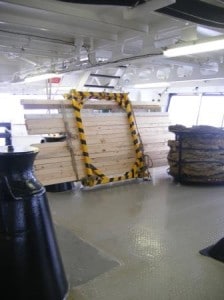
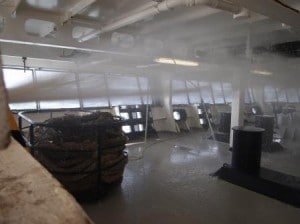
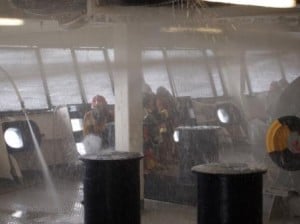
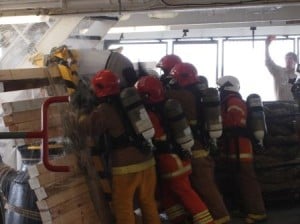
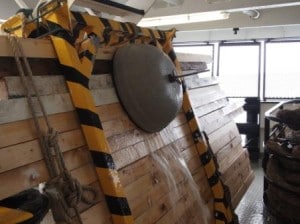
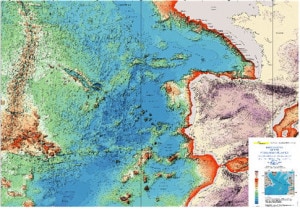
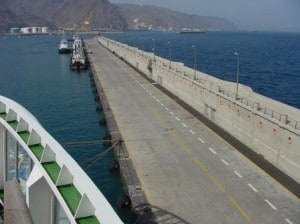

December 9, 2014 at 5:03 am
Very realistic drills on the spot! Totally different from the onboard drills we had in the past. Are these kind of trainings now an overall standard practice in Holland America Line only, or have these trainings been adopted in Carnival Corporation for all the cruise companies?
December 9, 2014 at 7:48 am
Good morning,
thank you for reading my blog.
No Carnival is not involved. This is pure holland america trying to raise the bar all the time.
Capt. Albert